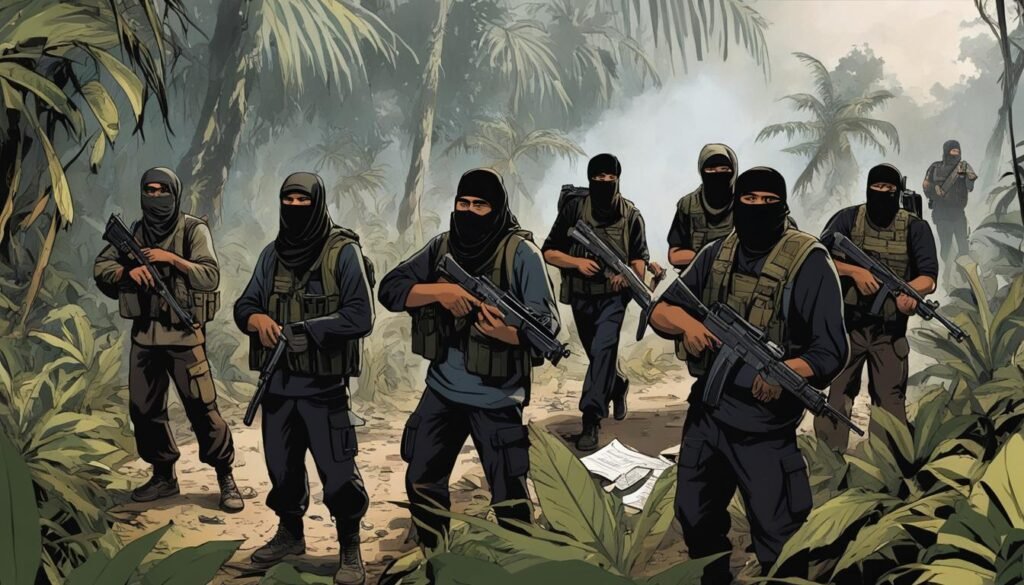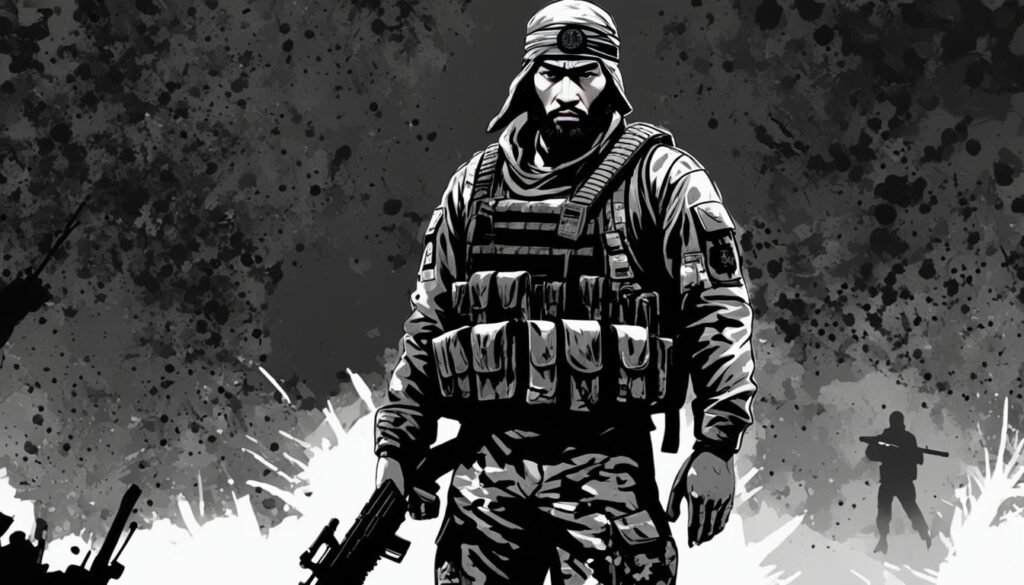The Abu Sayyaf Group (ASG) is an Islamic separatist organization founded in 1991 by Abdurajak Abubakar Janjalani. Janjalani, who was influenced by Al-Qaeda, formed the ASG as a splinter group of the Moro National Liberation Front (MNLF) with the aim of establishing an independent Muslim state in the southern Philippines.
In the 1990s, the ASG carried out a series of attacks, including bombings, kidnappings, and assassinations. It also had connections with Al-Qaeda and received support from them. The early 2000s saw major attacks and hostage situations by the ASG, leading to international counterterrorism efforts against the group.
Over time, the ASG faced decline in Al-Qaeda support, internal conflicts, and financial struggles. However, it resurged and pledged allegiance to ISIS in 2014. The ASG’s activities have had a significant impact on the Philippines’ security and politics, leading to the implementation of counterterrorism strategies by the government.
The ASG’s actions have also affected the socio-economic development of the regions where it operates, creating an atmosphere of fear and instability that hinders investments and economic growth.
Key Takeaways:
- The Abu Sayyaf Group (ASG) was founded in 1991 as an Islamic separatist organization aiming to establish an independent Muslim state in the southern Philippines.
- The ASG carried out a series of attacks, including bombings, kidnappings, and assassinations in the 1990s, with connections to Al-Qaeda.
- The ASG faced decline in Al-Qaeda support, internal conflicts, and financial struggles, but resurged and pledged allegiance to ISIS in 2014.
- The ASG’s activities have had a significant impact on the Philippines’ security and politics, leading to counterterrorism strategies by the government.
- The ASG’s actions have also hindered socio-economic development in the regions it operates in, creating instability and deterring investments.
Origins and Founding of the Abu Sayyaf Group
The Abu Sayyaf Group (ASG) was established in 1991 by Abdurajak Abubakar Janjalani, an Islamic extremist who had studied in the Middle East. Janjalani’s experiences and encounters with radical ideologies, including meeting Osama bin Laden, influenced his beliefs and motivated him to form a separatist organization.
Abdurajak Abubakar Janjalani and the Early Ideology
After returning to the Philippines, Janjalani broke away from the Moro National Liberation Front (MNLF) and founded the ASG. His vision was to create an independent Islamic state in the southern part of the country. Janjalani’s early ideology was centered around extremist Islamic principles, which he sought to implement through the ASG’s activities.
Split from the Moro National Liberation Front
The ASG’s origins can be traced back to its split from the MNLF, a larger Muslim separatist group in the Philippines. Janjalani’s departure from the MNLF was driven by disagreements over strategic approaches and ideological differences. The ASG emerged as a distinct organization with its own agenda and tactics.
The Influence of Al-Qaeda and Radicalization
Al-Qaeda played a significant role in the development and radicalization of the ASG. The group provided financial support, training, and guidance to the ASG, strengthening their capabilities and resources. The ideological alignment with Al-Qaeda’s extremist views further shaped the ASG’s activities and approach to achieving their objectives.
| Origins and Founding of the Abu Sayyaf Group | |
|---|---|
| Year | 1991 |
| Founder | Abdurajak Abubakar Janjalani |
| Ideology | Extremist Islamic principles |
| Moro National Liberation Front (MNLF) Split | Formation of separate organization with its own agenda |
| Al-Qaeda Influence | Financial support, training, and ideological alignment |
Abu Sayyaf’s Activities in the 1990s
During the 1990s, the Abu Sayyaf Group (ASG) engaged in a series of activities that marked its emergence as a violent extremist organization in the Philippines. These activities encompassed various aspects, including attacks, rising violence, kidnappings, high-profile crime, internal fragmentation, and leadership changes.
First Attacks and Rising Violence
The ASG conducted its initial attacks in the 1990s, employing tactics such as bombings and assassinations. These acts of violence contributed to the escalation of conflict and instability in the region. The ASG’s violent activities aimed to further its extremist ideology and establish its presence as a formidable force.
Kidnappings and High-Profile Crime
Kidnappings became a notorious activity for the ASG during this period. The group targeted both Filipinos and foreigners, seizing them to demand ransom or to advance their ideological agenda. Notably, the ASG carried out high-profile crimes such as abducting tourists at resorts and foreign workers, attracting significant media attention and international condemnation.
Internal Fragmentation and Leadership Changes
The ASG experienced internal fragmentation and frequent leadership changes during the 1990s. These dynamics affected the group’s operations and strategies. Internal disputes, ideological differences, and power struggles contributed to the evolution and transformation of the ASG, molding its objectives and modus operandi.

Relations with Al-Qaeda and the Global Jihad Movement
The Abu Sayyaf Group (ASG) maintained significant relations with Al-Qaeda and the wider global jihad movement. As a regional affiliate and ally of Al-Qaeda, the ASG received financial support and training from the terrorist organization, solidifying their collaboration.
Members of Al-Qaeda, including high-profile figures like Osama bin Laden and Khalid Shaikh Mohammed, collaborated with the ASG in various activities. This partnership included joint bomb plots and shared strategic objectives.
Over time, the ASG’s relationship with Al-Qaeda weakened due to arrests and increased counterterrorism efforts targeting both organizations. These interventions led to a decline in support from Al-Qaeda, forcing the ASG to adapt and seek alternative alliances.
The Abu Sayyaf in the Early 2000s
The early 2000s represented a pivotal period for the Abu Sayyaf Group (ASG), marked by significant attacks, hostage situations, international counterterrorism efforts, and leadership dynamics.
Major Attacks and Hostage Situations
The ASG orchestrated a series of major attacks during this time, notably the infamous Superferry 14 bombing in Manila Bay. This devastating event resulted in numerous casualties and demonstrated the ASG’s capability for large-scale acts of terrorism.
“The Superferry 14 bombing was a highly alarming incident that sent shockwaves throughout the Philippines and drew international attention to the ASG’s destructive potential.”
In addition to bombings, the ASG relied heavily on hostage-taking as a prominent tactic. Foreigners were specifically targeted in order to demand substantial ransoms, further fueling fears and highlighting the group’s capacity for strategic violence.
“Hostage situations became a recurring nightmare for both the victims and the international community, as the ASG weaponized kidnapping as a means to achieve their objectives and secure financial resources.”
Impact of International Counterterrorism
The early 2000s witnessed intensified international counterterrorism efforts against the ASG. Joint military operations, involving collaboration between various nations and the Philippine military, aimed to counter the group’s activities and cripple its infrastructure.
“International counterterrorism initiatives played an instrumental role in weakening the ASG’s operational capabilities and disrupting its networks. These concerted efforts demonstrated the global commitment to eradicating terrorism and ensuring regional security.”
Leadership Dynamics Post-2000
The ASG experienced significant changes in its leadership dynamics following the early 2000s. Counterterrorism operations and internal conflicts within the group contributed to a reshuffling of power and influence.
“The ASG’s leadership dynamics became a key factor in shaping its operational strategies and future course. Stability and cohesion within the leadership ranks provided the group with a distinct advantage, while internal conflicts posed challenges and potential vulnerabilities.”

Shift in Tactics: Kidnappings and Ransom Operations
A significant shift in the Abu Sayyaf Group’s (ASG) tactics has been observed, with a focus on kidnappings and ransom operations. This strategic change has allowed the ASG to generate funds for its operations and sustain its activities despite counterterrorism efforts.
Kidnappings conducted by the ASG target both Filipinos and foreigners, aiming to secure financial ransom for the release of captives. These operations have become a primary source of funding for the group, enabling them to continue their extremist activities and maintain their influence in the region.
To illustrate the severity of this shift in tactics, it is worth noting that the ASG has engaged in high-profile kidnappings, such as the abductions of tourists at resorts and foreign workers. These incidents have not only brought global attention to the plight of those affected but have also posed challenges for the Philippine government and international security forces.
To emphasize the impact of this shift, consider the table below, which provides an overview of the ASG’s kidnappings and ransom operations in recent years:
| Year | Number of Kidnappings | Ransom Amount (USD) |
|---|---|---|
| 2017 | 15 | 5,000,000 |
| 2018 | 19 | 8,500,000 |
| 2019 | 23 | 12,000,000 |
| 2020 | 17 | 9,200,000 |
This data highlights the increasing frequency of kidnappings and the substantial ransom amounts demanded by the ASG in recent years. It underscores the financial viability of this tactic and its significance in the group’s overall operations.
The ASG’s shift towards kidnappings and ransom operations has posed significant challenges for counterterrorism efforts in the region. The need for continued international collaboration and strategic responses remains crucial to mitigate the threat posed by the ASG and secure the safety of those at risk.

Decline in Al-Qaeda Support and Internal Conflicts
The Abu Sayyaf Group (ASG) experienced a decline in support from Al-Qaeda, which had played a significant role in sustaining the group for many years. This decline can be attributed to the increased military operations and counterterrorism efforts specifically targeting the ASG. As international cooperation intensified in the fight against terrorism, Al-Qaeda’s ability to provide resources, funding, and training to the ASG diminished, weakening their alliance.
Furthermore, the ASG encountered internal conflicts that further contributed to its decline. These conflicts arose from disagreements over objectives, strategies, and leadership within the group, leading to factionalism. Different factions within the ASG emerged, each with their own agendas and approaches to achieving their goals. The internal fragmentation weakened the overall capacity and effectiveness of the ASG, hindering their coordinated actions and capacity to carry out significant attacks.
The consequences of military operations and internal conflicts had a significant impact on the ASG’s ability to sustain its operations and maintain its influence. The declining support from Al-Qaeda, coupled with the emergence of factions and internal power struggles, posed challenges to the group’s cohesion and effectiveness as a unified entity.
Consequences of Military Operations
The ASG faced the consequences of increased military operations launched against them by the Philippine government and international partners. These military actions aimed to disrupt and neutralize the ASG’s networks, safe havens, and capabilities. The intensified military operations included raids, airstrikes, and targeted operations that focused on dismantling the ASG’s infrastructure, capturing key leaders, and rescuing hostages.
The military operations not only inflicted direct casualties and damage on the ASG but also disrupted their logistics and communications networks. The ASG faced heightened risks and challenges in transporting weapons, funds, and resources, hindering their ability to carry out large-scale attacks and sustain their activities.
Emergence of Factions within Abu Sayyaf
The internal conflicts within the ASG led to the emergence of factions within the group. These factions had differing objectives, strategies, and alliances, leading to fragmented decision-making and competition for resources and influence. The factions often pursued their own agendas, which sometimes deviated from the overall goals of the ASG.
While some factions remained aligned with the original objectives of the ASG, such as the establishment of an independent Islamic state, others shifted their focus towards criminal activities and personal gains. These internal divisions created complexities and challenges for the ASG, affecting their operational capabilities and undermining their ability to project a unified front.
Financial Struggles and Criminal Activities
The decline in support from Al-Qaeda and the internal conflicts within the ASG resulted in financial struggles for the group. The loss of external funding and resources forced the ASG to find alternative means to sustain their operations. To compensate for the financial shortfall, the ASG turned to criminal activities such as extortion, kidnapping for ransom, robbery, and smuggling.
Extortion activities targeted businesses, individuals, and even local communities. Kidnapping for ransom became a major source of income for the ASG, particularly with the targeting of foreigners who are more likely to attract higher ransom payments. The ASG’s involvement in criminal activities further eroded their reputation, making them appear more as a criminal organization driven by financial gain rather than a politically motivated group.

| Consequences of Military Operations | Emergence of Factions within Abu Sayyaf | Financial Struggles and Criminal Activities |
|---|---|---|
| Military actions targeted ASG infrastructure and leadership | Internal conflicts led to the formation of different factions with varying objectives | Loss of external funding led to reliance on criminal activities for financial sustainability |
| Disrupted logistics and communication networks | Fragmented decision-making and competition for resources | Extortion, kidnapping for ransom, and smuggling became primary income sources |
| Challenges in transporting weapons, funds, and resources | Diverted focus from overall ASG objectives | Erosion of reputation as a politically motivated group |
The Superferry 14 Bombing and Other Notable Attacks
The Abu Sayyaf Group (ASG) carried out several notable attacks during its history, demonstrating its capability for large-scale acts of violence. One such attack was the Superferry 14 bombing, which took place in 2004 and resulted in the loss of numerous lives. This attack specifically targeted a passenger ferry in Manila Bay, showcasing the ASG’s ability to carry out deadly assaults on civilian targets.
Additionally, the ASG conducted other significant attacks during this period, including the infamous “Valentine’s Day Bombings.” These attacks, which occurred on February 14th, attracted international attention and further heightened counterterrorism efforts against the ASG.
The Superferry 14 bombing and other notable attacks carried out by the ASG serve as stark reminders of the group’s violent and extremist nature. These acts of terror have had far-reaching consequences and underscore the importance of ongoing efforts to combat and dismantle the ASG.

Relevance in the Post-9/11 World
The Abu Sayyaf Group (ASG) gained increased attention and faced intensified action in the post-9/11 world. The global landscape changed dramatically after the September 11 attacks, prompting a proactive response to combat terrorism worldwide.
Operation Enduring Freedom and Joint Military Efforts
Operation Enduring Freedom, a military campaign launched in response to the 9/11 attacks, had a significant impact on counterterrorism efforts against the ASG. As part of this operation, U.S. forces were deployed to the Philippines to collaborate with the Philippine military in combating terrorism. The joint military efforts aimed to disrupt the ASG’s activities and dismantle its networks.
International Designation as a Terrorist Organization
The ASG gained international recognition as a terrorist organization, further isolating and endangering the group. This designation by multiple countries reinforced the seriousness of the ASG’s activities and allowed for greater international cooperation in countering its operations. It also placed the ASG under increased scrutiny and limited its access to funding and resources.
The Evolving Threat in Southeast Asia
The ASG’s activities highlighted the evolving threat of terrorism in Southeast Asia. The region became a hotbed for extremist ideologies and the manifestation of violent extremism. The ASG’s presence, along with the activities of similar organizations, posed persistent challenges to regional security. Governments in Southeast Asia faced the complex task of addressing this evolving threat while ensuring the safety and stability of their nations.
| Effects of Relevance in the Post-9/11 World |
|---|
| Increased international collaboration in counterterrorism efforts |
| Heightened security measures in Southeast Asia |
| Disruption of the ASG’s operations and networks |
| Greater global awareness of the ASG and its tactics |
| Ongoing evaluation and adaptation of counterterrorism strategies |
Impact on the Philippines’ Security and Politics
The activities of the Abu Sayyaf Group (ASG) have left a lasting impact on the security and politics of the Philippines. The group’s acts of terrorism, including bombings, kidnappings, and attacks, have instilled fear and created an atmosphere of instability in the country. The Philippine government has been compelled to implement comprehensive counterterrorism strategies to address the grave threats posed by the ASG and ensure the safety of its citizens.
The ASG’s activities have also had a significant influence on the political landscape of the Philippines. Discussions surrounding national security, terrorism, and the protection of minority rights have been shaped by the actions of the ASG. The presence of a violent extremist group like the ASG has forced policymakers to continuously evaluate and adapt their strategies to combat the threat effectively.
To protect the nation’s security and stability, the Philippine government has been actively involved in implementing counterterrorism measures. These strategies involve a combination of military actions, international collaboration, and legal efforts. The government has been engaged in military operations targeting ASG strongholds, conducting raids, and engaging in armed clashes to neutralize the group’s capabilities.
International collaboration and assistance have also played a crucial role in combatting the ASG. Various countries have provided intelligence sharing, military training, and technological advancements to aid the Philippine military in its counterterrorism efforts. Additionally, legal and diplomatic efforts have been undertaken to curb terrorism, including the enactment of laws and international agreements to enhance prosecution and cooperation among nations.
The ASG’s activities and the government’s response have engendered a complex relationship between security, politics, and socioeconomic conditions in the Philippines. It emphasizes the need for ongoing assessment, future projections, and a comprehensive approach that addresses the root causes of extremism while promoting education and awareness as vital tools in counterterrorism efforts.
Resurgence and Affiliation with ISIS
The Abu Sayyaf Group (ASG) has experienced a resurgence in recent years, reasserting its presence in the Southeast Asia region. One significant development has been the ASG’s affiliation with the Islamic State (ISIS), a global jihadist organization. This affiliation has further internationalized the activities of the ASG, amplifying its threat and reach.
One of the crucial milestones in this affiliation was the ASG leaders’ pledge of allegiance to ISIS and its leader, Abu Bakr al-Baghdadi. This act of pledging loyalty has solidified the ties between the two groups and fostered a deeper integration of ASG’s operations within the ISIS network.
Pledging Allegiance to the Islamic State
The pledge of allegiance by ASG leaders, including Isnilon Hapilon, marked a significant shift in the group’s identity and objectives. Isnilon Hapilon emerged as the acting Emir of the Southeast Asia region, assuming a leadership role in consolidating pro-ISIS groups and spreading the jihadist ideology.
Continued Threat in the Southeast Asia Region
The affiliation with ISIS has bolstered the threat posed by the ASG in the Southeast Asia region. The ASG has increased its recruitment efforts, seeking to attract individuals who resonate with the extremist ideologies propagated by ISIS. The convergence of ASG’s local knowledge and networks with the broader resources and tactics of ISIS presents an ongoing security challenge.
The ASG’s affiliation with ISIS and the continued threat it poses require sustained efforts from regional and international actors to counter and dismantle the group’s operations. Heightened security measures, intelligence sharing, and collaborative counterterrorism initiatives remain crucial in addressing the resurgent ASG and its affiliation with ISIS.
Modern Tactics and Ideological Shifts
The Abu Sayyaf Group (ASG) has demonstrated its adaptability by combining traditional methods with modern tactics in recent years. One of their primary activities is kidnapping for ransom, where they use social media and technology to communicate and execute their operations. This strategic use of technology allows them to reach a wider audience, plan their abductions more efficiently, and demand higher ransom amounts.
Furthermore, the ASG has undergone ideological shifts and aligned itself with the global jihadist ideology propagated by ISIS. This shift has had a profound impact on their recruitment strategies, as they now focus on attracting individuals who share this extremist ideology. Their targets and objectives have also been influenced by this alignment, as they now seek to establish a caliphate in the region and spread radical ideologies.
In summary, the ASG’s adoption of modern tactics, such as utilizing technology in their operations, and ideological shifts towards global jihadism have allowed them to evolve and remain a significant threat in the Southeast Asia region.
Government Response and Counterterrorism Strategies
The Philippine government has implemented various counterterrorism strategies to address the threats posed by the Abu Sayyaf Group (ASG). These strategies encompass a range of actions, including military operations, international collaboration and assistance, as well as legal and diplomatic efforts.
Philippine Military Actions
The Philippine military has played a crucial role in combating the ASG. They have conducted targeted operations to dismantle ASG strongholds, carrying out raids and engaging in armed clashes with the group. These military actions aim to weaken the ASG’s capabilities and disrupt their activities.
International Collaboration and Assistance
International collaboration and assistance have been essential in combating the ASG. Countries from around the world have come together to share intelligence, provide training to the Philippine military, and assist in technological advancements. This collaboration ensures a coordinated and united front against the ASG’s terrorist activities.
Legal and Diplomatic Efforts to Curb Terrorism
The Philippine government has also undertaken legal and diplomatic efforts to curb terrorism, specifically targeting the activities of the ASG. Laws have been passed to enhance the prosecution of terrorism-related crimes, enabling more effective legal actions against ASG members. Additionally, international agreements have been established to facilitate cooperation among nations in the fight against terrorism.
| Government Response | Counterterrorism Strategies |
|---|---|
| Philippine Military Actions | International Collaboration and Assistance |
| Targeted operations | Sharing intelligence |
| Raids and armed clashes | Providing training |
| Disrupting ASG strongholds | Assisting in technological advancements |
| Legal and Diplomatic Efforts | |
| Passage of laws to enhance prosecution | |
| Establishing international agreements for cooperation | |
The combined efforts of the Philippine government, the military, and international partners reflect a comprehensive approach in addressing the ASG’s threats. Through military actions, collaboration, and legal and diplomatic efforts, counterterrorism strategies are actively pursued to safeguard the Philippines and the international community.
Socio-Economic Impact of the Abu Sayyaf Group
The activities of the Abu Sayyaf Group (ASG) have had significant socio-economic implications in the regions where they operate. The presence of the ASG has created an atmosphere of instability and fear, deterring investments and hindering economic development in these areas. The ASG’s criminal activities, such as kidnappings and extortion, have had a detrimental effect on local businesses and communities.
The socio-economic impact of the ASG poses challenges for the affected regions, requiring focused efforts to address the root causes of extremism and promote economic growth. The presence of the ASG has limited the potential for businesses to thrive and discouraged investors from contributing to the development of these regions.
The ASG’s kidnappings and extortion activities have not only hindered the growth of local businesses but have also negatively affected the livelihoods of communities. The fear instilled by the ASG has led to a decline in tourism, further impacting the economic prospects of the affected regions.
To overcome the socio-economic challenges caused by the ASG, it is crucial to focus on addressing the root causes of extremism through education, awareness, and economic development initiatives. By promoting education and raising awareness about the destructive consequences of terrorism, communities can build resilience against extremist ideologies. Additionally, implementing strategies to stimulate economic growth, create job opportunities, and improve infrastructure can help alleviate poverty and reduce vulnerability to recruitment by extremist groups.
Efforts to counter the socio-economic impact of the ASG should be an integral part of the broader counterterrorism strategy, recognizing that addressing the underlying grievances and needs of the affected regions is crucial for long-term stability and peace.
Conclusion
In conclusion, the Abu Sayyaf Group has left a significant impact on the Philippines and the Southeast Asia region with its history of violence and extremism. Over the years, the group has evolved, influenced by ideological factors, shifting alliances, and external counterterrorism efforts. To assess the current situation, it is essential to evaluate the group’s capabilities, leadership dynamics, and ongoing threats.
Looking ahead, future projections of the Abu Sayyaf Group’s global relevance require careful analysis of geopolitical developments, regional dynamics, and counterterrorism strategies. The group’s trajectory will depend on various factors and how they interact in the complex landscape of international terrorism. The challenge of addressing the root causes of extremism calls for a holistic approach that includes education and awareness.
Educational initiatives and raising awareness about the dangers of terrorism play a critical role in preventing radicalization and promoting resilience against terrorist ideologies. By focusing on education and awareness, long-term counterterrorism strategies can be developed to address the root causes of extremism and create a safer future for the Philippines and the global community.
FAQ
What is the history of the Abu Sayyaf Group?
The Abu Sayyaf Group (ASG) is an Islamic separatist organization founded in 1991 by Abdurajak Abubakar Janjalani. It emerged as a splinter group of the Moro National Liberation Front (MNLF) with the aim of establishing an independent Muslim state in the southern Philippines.
Who founded the Abu Sayyaf Group?
The Abu Sayyaf Group was founded by Abdurajak Abubakar Janjalani in 1991.
What influenced the formation of the Abu Sayyaf Group?
Abdurajak Abubakar Janjalani, the founder of the Abu Sayyaf Group, was influenced by his travels, radical ideologies, and encounters with Osama bin Laden. He formed the ASG as a splinter group of the MNLF with the aim of establishing an independent Islamic state.
What were the activities of the Abu Sayyaf Group in the 1990s?
In the 1990s, the Abu Sayyaf Group carried out a series of attacks, including bombings, kidnappings, and high-profile crimes. They targeted both Filipinos and foreigners and engaged in internal conflicts and leadership changes.
Did the Abu Sayyaf Group have connections with Al-Qaeda?
Yes, the Abu Sayyaf Group had significant connections with Al-Qaeda. They received financial support, training, and support from Al-Qaeda, and collaborated with them in various activities, including bomb plots.
What were the major attacks and hostage situations by the Abu Sayyaf Group in the early 2000s?
The Abu Sayyaf Group carried out major attacks in the early 2000s, including the Superferry 14 bombing in Manila Bay, which resulted in numerous casualties. They also engaged in hostage situations, targeting both Filipinos and foreigners.
What were the tactics of the Abu Sayyaf Group?
The tactics of the Abu Sayyaf Group shifted towards kidnappings and ransom operations. They kidnapped individuals and demanded ransom for their release, using these activities to generate funds for their operations.
Did the Abu Sayyaf Group face any decline in support?
Yes, over time, the Abu Sayyaf Group faced a decline in support from Al-Qaeda, leading to financial struggles. Internal conflicts and leadership changes within the group also contributed to its decline.
What were some notable attacks by the Abu Sayyaf Group?
The Abu Sayyaf Group carried out the infamous Superferry 14 bombing in 2004, which resulted in numerous deaths. They also conducted other notable attacks, such as the “Valentine’s Day Bombings.”
How did the international community respond to the Abu Sayyaf Group?
The international community, including efforts under Operation Enduring Freedom, deployed forces and conducted joint military operations to combat the Abu Sayyaf Group. The ASG was also designated as a terrorist organization, further isolating them.
What impact did the Abu Sayyaf Group have on the Philippines?
The Abu Sayyaf Group’s activities have had a significant impact on the security and politics of the Philippines. They have created an atmosphere of fear and instability, leading to the implementation of counterterrorism strategies and shaping discussions on national security.
Did the Abu Sayyaf Group pledge allegiance to any other extremist organization?
Yes, the Abu Sayyaf Group pledged allegiance to the Islamic State (ISIS). ASG leaders, including Isnilon Hapilon, pledged loyalty to ISIS and its leader, Abu Bakr al-Baghdadi.
What has been the government’s response to the Abu Sayyaf Group?
The Philippine government has implemented various counterterrorism strategies, including military actions, international collaboration, and legal efforts, to address the threats posed by the Abu Sayyaf Group.
What socio-economic impact has the Abu Sayyaf Group had on the regions where they operate?
The presence of the Abu Sayyaf Group has created an atmosphere of instability and fear, deterring investments and economic development in the affected regions. Their criminal activities have hindered the growth of local businesses and affected the livelihoods of communities.
What is the role of education and awareness in countering terrorism?
Education and awareness play a crucial role in addressing the root causes of extremism and promoting resilience against terrorist ideologies. Efforts in education and awareness can contribute to long-term counterterrorism strategies and the prevention of radicalization.


